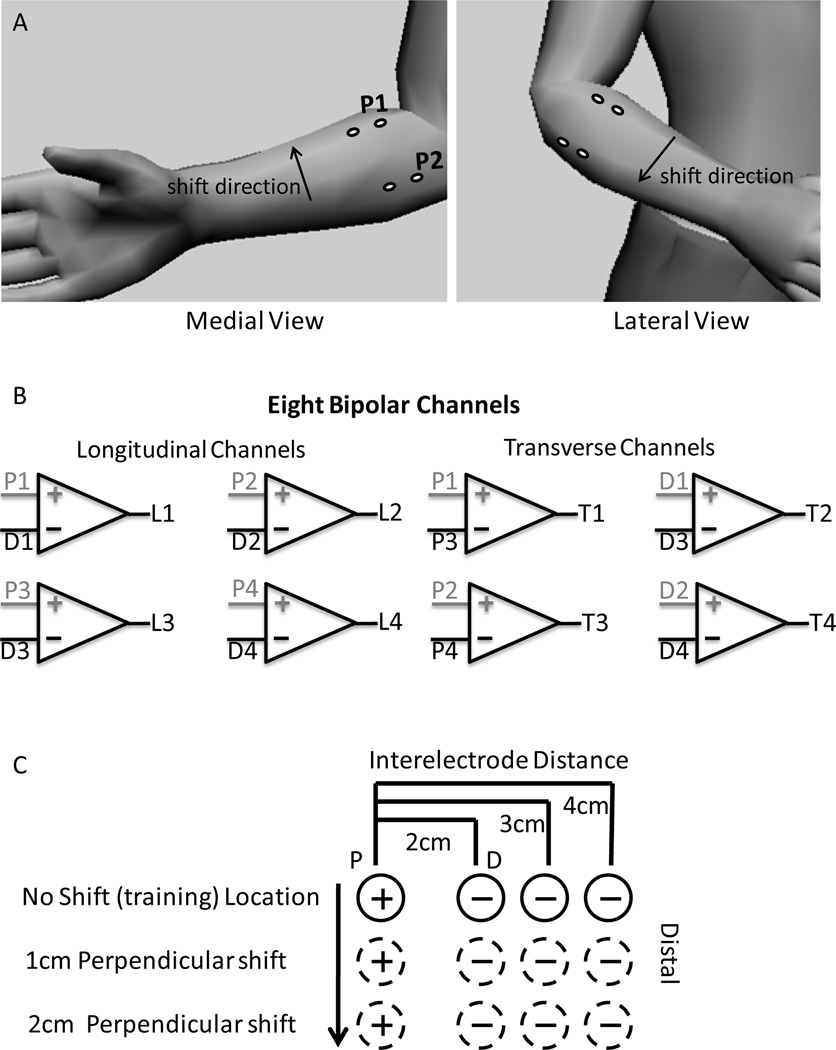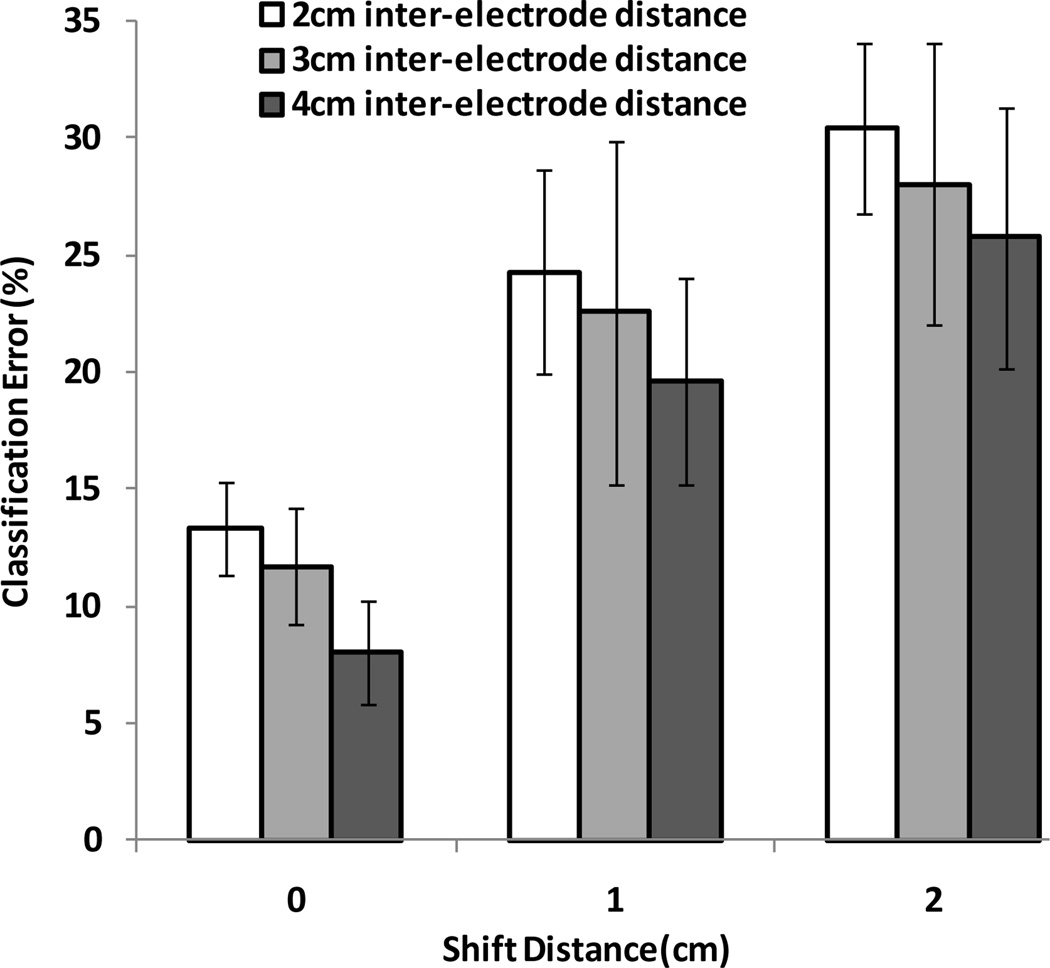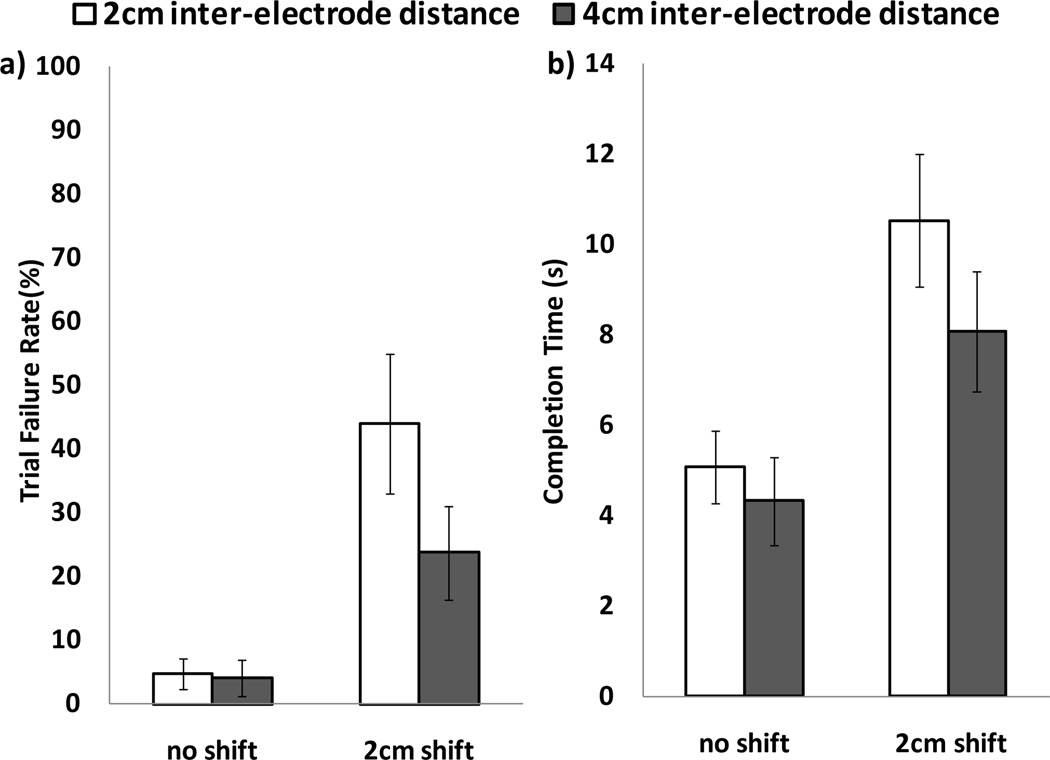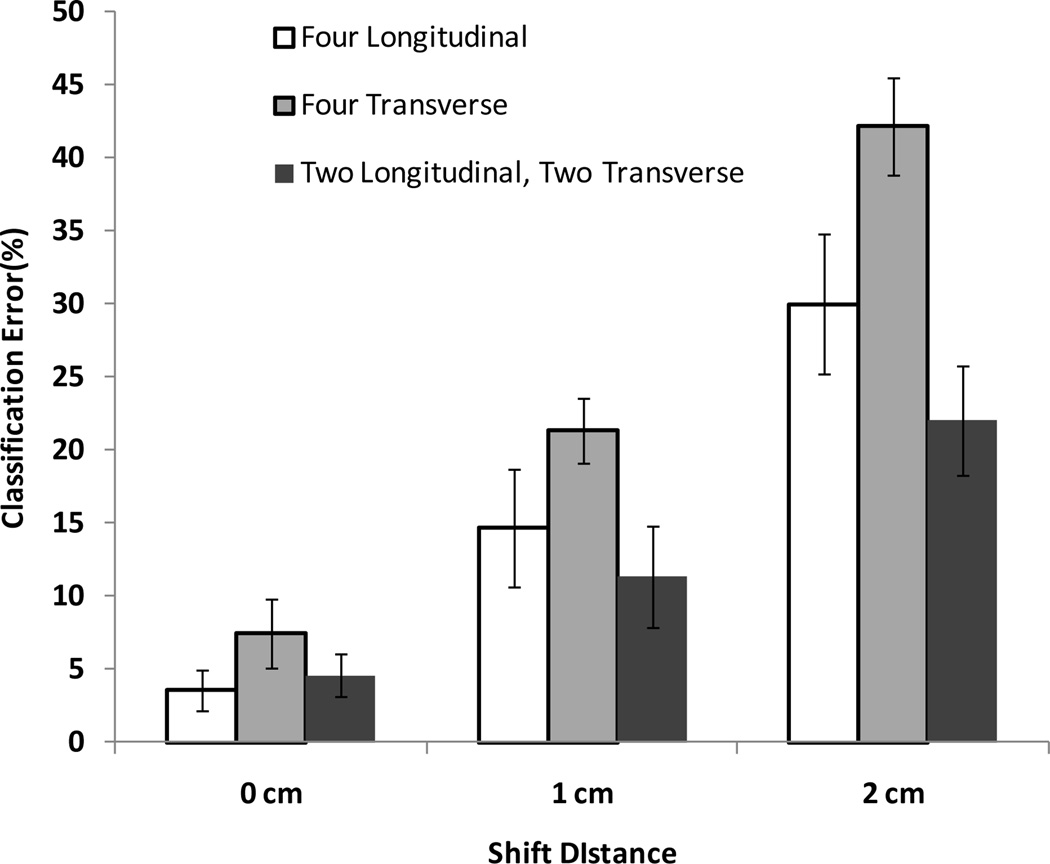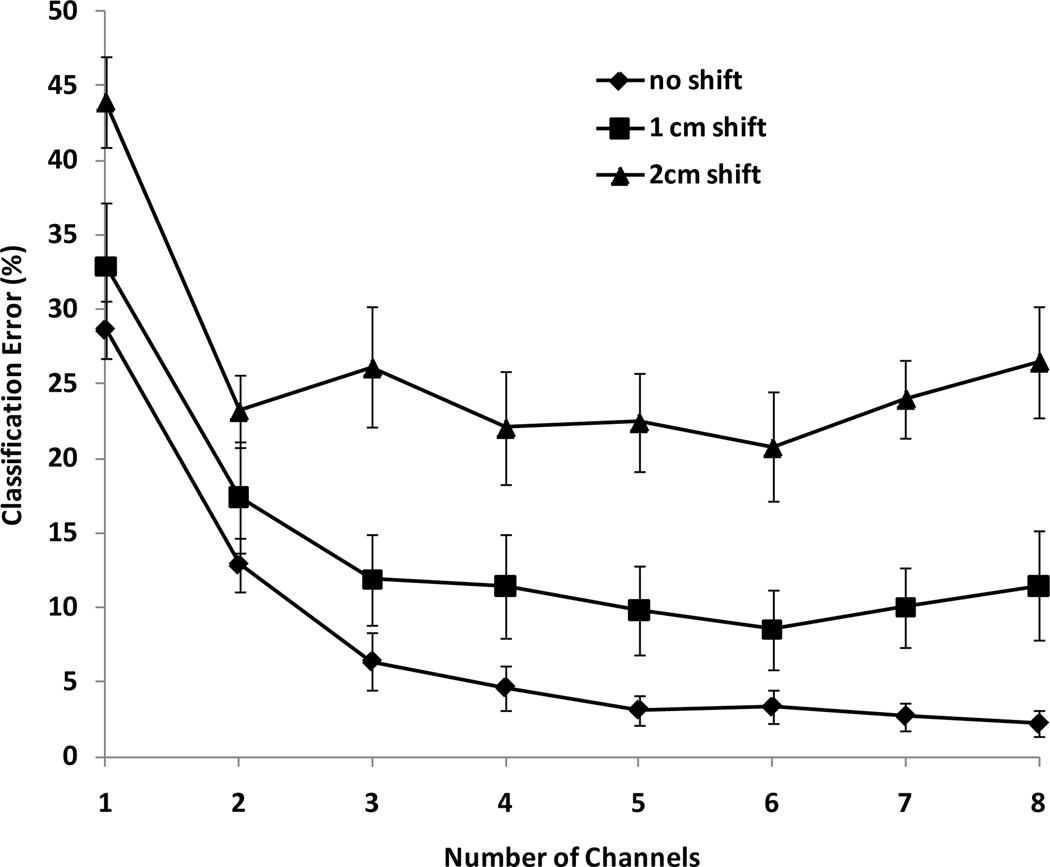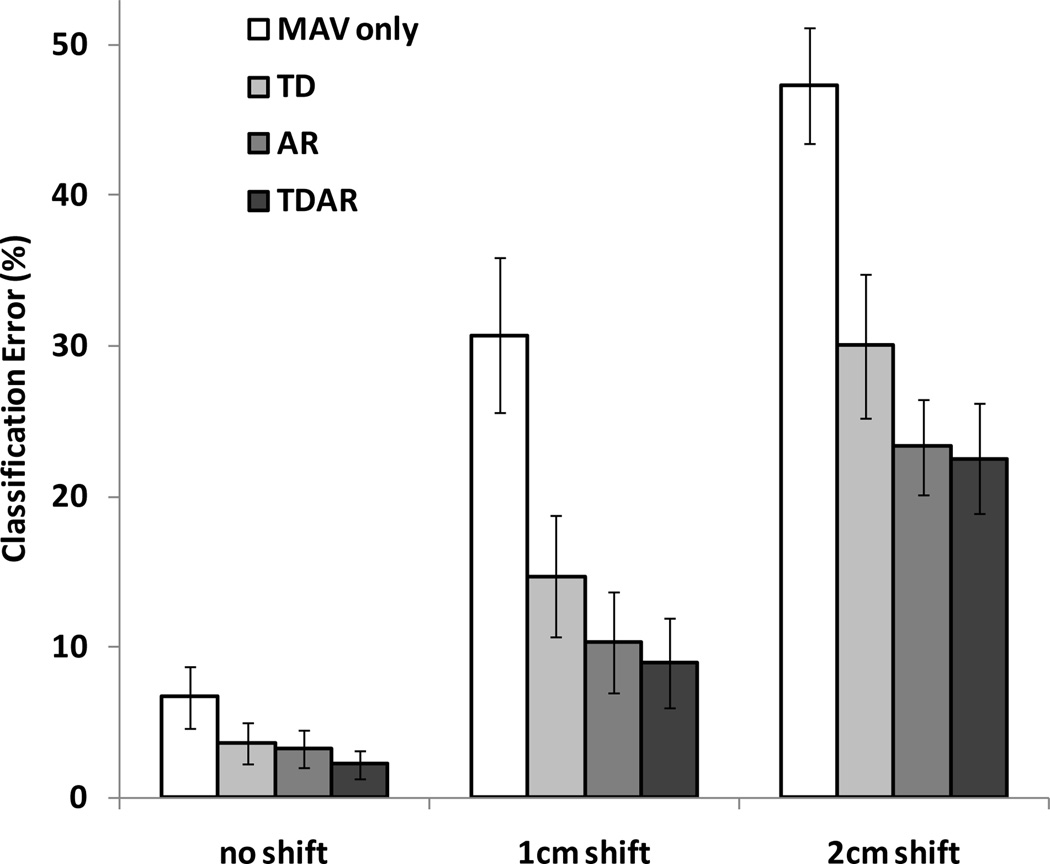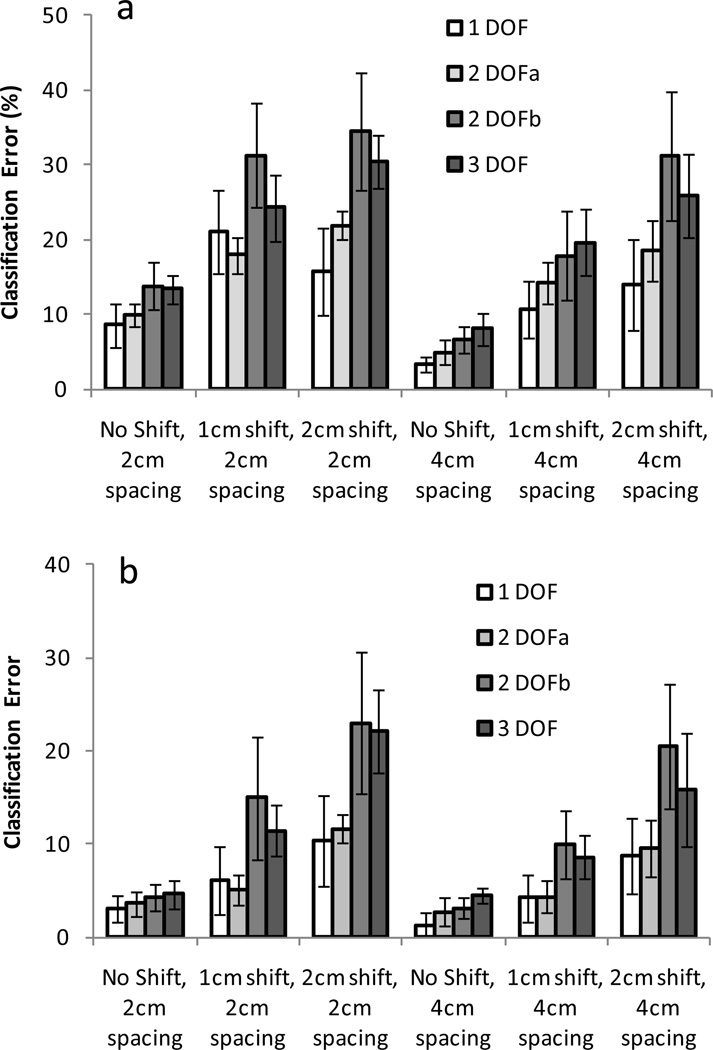Abstract
Pattern recognition of myoelectric signals for prosthesis control has been extensively studied in research settings and is close to clinical implementation. These systems are capable of intuitively controlling the next generation of dexterous prosthetic hands. However, pattern recognition systems perform poorly in the presence of electrode shift, defined as movement of surface electrodes with respect to the underlying muscles. This work focused on investigating the optimal interelectrode distance, channel configuration, and EMG feature sets for myoelectric pattern recognition in the presence of electrode shift. Increasing interelectrode distance from 2 cm to 4 cm improved pattern recognition system performance in terms of classification error and controllability (p<0.01). Additionally, for a constant number of channels, an electrode configuration that included electrodes oriented both longitudinally and perpendicularly with respect to muscle fibers improved robustness in the presence of electrode shift (p<0.05). We investigated the effect of the number of recording channels with and without electrode shift and found that four to six channels were sufficient for pattern recognition control. Finally, we investigated different feature sets for pattern recognition control using a LDA classifier and found that an autoregressive set significantly (p<0.01) reduced sensitivity to electrode shift compared to a traditional time-domain feature set.
Index Terms: Electrode Shift, Electromyography (EMG), Pattern Recognition, Electrode Configuration
I. Introduction
UPPER limb amputation is a major cause of disability throughout the world. It affects approximately 25,000 people in the U.S. alone, almost 80% of whom choose to use a prosthesis on a daily basis [1]. Three types of prostheses are widely available for people with upper limb amputations: passive, body powered, and electrically powered. Passive prostheses are often employed for cosmetic purposes and have limited functionality. Body-powered prostheses are used to restore basic tasks such as opening and closing a terminal device. These devices are often used because they are simple, robust, and relatively inexpensive. Electrically powered prostheses are advantageous because they require less user effort, as movement is actuated with DC motors. They can be controlled through a variety of means such as force sensors, linear potentiometers, and electromyographic (EMG) signals. Electrically powered prostheses restore some functionality to amputees, but control of these devices is typically limited to only one or two degrees of freedom (DOF) [2–4].
Pattern recognition-based myoelectric control has been studied for decades and has demonstrated the potential to control more DOFs than conventional control techniques [5]. This approach is based on the premise that amputees can voluntarily generate distinct, repeatable EMG signal patterns for each motion class [6]. These systems are most intuitive when the EMG patterns are mapped to physiologically appropriate DOFs in the prosthesis. After significant research initiatives at multiple academic institutions, pattern recognition is nearing clinical implementation [7], [8]. However, the clinical reliability of pattern recognition-based myoelectric control systems is still challenged by some issues including effects of socket loading and limb orientation [9], variations in muscle contraction effort [10], and changes in electrode position—termed electrode shift—during donning/doffing and daily use [11], [12].
This work is a continuation of a previous study [12] on mitigating the effects of electrode shift on pattern recognition systems through modification of the signal detection interface. The underlying hypothesis of this work was that pattern recognition classifiers trained with nonselective, global EMG recordings are less sensitive to electrode shift than classifiers trained with selective EMG recordings. Additional properties of the signal detection interface are considered here such as interelectrode distance, channel configuration, and the number of recording channels. Also, the effects of different feature sets extracted from the myoelectric signal are considered.
A primary factor affecting the signal selectivity of EMG recordings is the interelectrode distance, which is the distance between the two electrode poles that form a bipolar differential channel. A rough estimate of electrode detection volume is a sphere with radius equal to the interelectrode distance [13]. Most research studies have been conducted with interelectrode distances of approximately 2 cm, which yield relatively selective recordings. This spacing is based on SENIAM guidelines [14], which help to standardize EMG measurement among research labs. Larger interelectrode distances increase the likelihood of muscle signal crosstalk, but the relative magnitude of electrode shift relative to the electrode detection volume decreases, potentially reducing the effects of electrode shift. In this study, we analyzed the effect of interelectrode distance on the performance of pattern recognition algorithms in the presence of electrode shift using both classification error and controllability of a virtual prosthesis as quantification metrics. A preliminary version of this work has appeared [15].
The effects of channel orientation on myoelectric pattern recognition were considered in a previous study [12]. The results of this study demonstrated that the same number of electrode poles, a combined classifier using both longitudinal and transverse channel orientations outperformed classifiers that used only one channel orientation. A limitation of this result was that the number of recording channels was not constant across conditions. In the present study, the number of channels was held constant and the best channel configuration was determined.
The number of channels used for classification of EMG signals differs between previous studies based on the classification problem and available recording equipment. Four channels have been previously used in myoelectric pattern recognition control studies with transradial amputees [16], [17]. One study [18] showed that four transverse channels provided sufficient information for myoelectric control of 10 motion classes using forearm muscles and that additional channels did not increase classification accuracy. Other studies have found a similar saturation effect on classification accuracy with increasing numbers of channels [19], [20]. In the present study, we examined how the number channels affected the robustness of the pattern recognition system in the presence of electrode shift.
A large number of research studies have investigated the representation and classification of myoelectric signals for pattern recognition control [6], [21–34]. Many combinations of feature sets and classifiers have been shown to effectively represent multichannel EMG signal patterns. In our previous study [12], we compared the performance of a linear and a non-linear classifier with and without electrode shift. Similarly to previous reports [18], we found that without electrode shift the classification accuracy of both classifiers was comparable; however, with electrode shift, the linear discriminant analysis classifier generalized better than the nonlinear multilayer perceptron classifier [12]. In this study, we also considered the signal representation step of myoelectric control by comparing different feature sets using linear discriminant analysis. Time-domain (TD) features classified by linear discriminant analysis have been shown to be efficient and effective in real-time control [28], [35], [36]. However, autoregressive (AR) features have also shown promise in previous myoelectric control studies [22], [30], [37], [38], and both sets are tested in this study in the presence of electrode shift.
II. Methods
A. Data Collection
Seven non-amputee subjects participated in this study, which was approved by Northwestern University Institutional Review Board. Four control sites were spaced evenly around the circumference of the forearm. At each control site, two monopolar Ag/AgCl surface electrodes with a diameter of 1 cm were placed longitudinally with respect to the proximal forearm (Fig. 1A). A ground electrode was placed on a bony region on the elbow, away from muscles of interest. Eight differential EMG channels were formed from these eight electrodes: four longitudinal channels and four transverse channels (see Fig. 1B).
Fig. 1.
Electrode pole placement and channel configuration. A. The four control sites were evenly spaced around the forearm. P1–P4 refer to the four proximal poles and D1–D4 refer to the four distal poles. B. From the four control sites, eight recording channels were formed: four longitudinal channels (L1, L2, L3, L4) and four transverse channels (T1, T2, T3, T4). Longitudinal channels were a differential of the proximal and distal pole at a single control site. Transverse channels were a differential of a pole from one control site and the corresponding pole from the control site on the opposite side of the arm. C. Three interelectrode distances were tested for longitudinal channels: 2 cm, 3 cm, and 4 cm. For each interelectrode distance and condition tested in this study, the classifier was tested at the no shift location, 1 cm perpendicular shift, and 2cm perpendicular shift.
Training data were recorded at three different interelectrode distances: the distal electrode was placed either 2 cm, 3 cm, or 4 cm from the proximal electrode (Fig. 1C). One set of training data was collected for each distal electrode location. Seven different motion classes were tested: wrist flexion, wrist extension, forearm pronation, forearm supination, hand open, hand close, and relaxed (no motion), yielding a total of three degrees of freedom: one forearm DOF, one wrist DOF and one hand DOF. Subjects were prompted by software to perform two repetitions of each motion class in a randomized order and held the contractions for 4 s and made repeatable, constant-force contractions to the best of their ability.
Test data for each of the three interelectrode distances were collected by a similar procedure. In addition, data for each of the three interelectrode distances were collected with all electrodes shifted to 1 cm and 2 cm locations in the direction perpendicular to the muscle fibers (Fig. 1 A&C). In total, test data including each motion class were obtained for nine different electrode placements for each subject.
B. Interelectrode Distance Testing
Controllability for interelectrode distance was assessed using the Target Achievement Control (TAC) test. The TAC test is described in detail elsewhere [12], [39], [40]. Briefly, the subject controls a virtual prosthesis that can move in any of the trained DOFs, which in this study were forearm rotation, wrist flexion/extension, and hand open/close. The speed was proportionally controlled based on the mean absolute value of EMG signals across all the channels, normalized for each subject for a specific motion class. Subjects had to move the virtual prosthesis into six target postures. The virtual prosthesis changed color when it was in the target posture (with a small tolerance for error). The subject had to remain in the target posture for 2 s to complete a trial. TAC tests were completed for interelectrode distances of 2 cm and 4 cm at the no shift locations and the 2 cm shift locations. Only two channels were used for the TAC test: one longitudinal channel on flexors and one longitudinal channel on extensors (L1 and L3 in Fig. 1B). In this experiment, real-time performance was measured in terms of subject failure rate and average time to completion. Failure rate was defined as the percentage of trials the subject did not complete within the allotted time of 17 s. Average completion time was defined as the average time for a subject to correctly position the virtual prosthesis in the target zone, including the 2 s dwell time.
C. Electrode Configuration Testing
Electrode configuration was analyzed in this study by selecting the best combination of four channels based on classification performance at all three shift locations (0 cm, 1 cm and 2 cm) with a 2 cm interelectrode distance. Every possible combination of four channels from the eight recorded channels (Fig1B) was trained at the no shift location and tested at the no shift, 1 cm, and 2 cm shift locations. The weighted average error score was calculated using Equation 1 and used to determine the subset of channels that performed best across all shift conditions:
| (1) |
E0, E1, and E2 corresponded to the classification error of the selected channel at the no shift, 1 cm shift, and 2 cm shift locations, respectively. Ew is the weighted average error. Weighting was designed to emphasize scores closer to the training location as small shifts are likely to be more common during prosthesis use.
D. Number of Electrode Channels Testing
In order to determine the effects of electrode shift with different numbers of recording channels, we analyzed subjects’ performance using from one to eight channels. Every possible combination of channels was tested and a weighted error was assigned to each combination. For each number of channels, the combination that had the lowest weighted error was determined.
E. Myoelectric Feature Testing
The pattern recognition system architecture was the same as that used in previous research [12]. Briefly, preprocessing consisted of high-pass filtering at 20 Hz and sampling at 1 kHz. Each motion class was trained on 16 s of active data, and tested on a different 16 s of data. Data were divided for each class into 250 ms windows with 50 ms overlap [16], [39]. Due to limitations of the software at the time of the experiment, only TD features were extracted online and used for controllability testing. However, in postprocessing, TD + AR features were extracted for analysis in all conditions in this experiment. Linear discriminant analysis was used for feature classification.
F. Statistical Analysis
Because data were normally distributed, differences in performance for all cases were analyzed with a general linear model using classification error as the response variable and subject as a random factor. Shift distance, interelectrode distance, electrode configuration, and feature choice were used as fixed factors. Post-hoc comparisons with a Bonferroni correction factor were analyzed for each statistically significant factor of interest.
III. Results
A. Effects of Interelectrode Distance
Larger interelectrode distances consistently produced lower classification errors (p<0.01) (Fig. 2). A post-hoc comparison of interactions at each electrode shift distance revealed that interelectrode distance was not significant at the no shift location. At the 1 cm shift location, the 4 cm interelectrode distance was significantly better (p<0.05) than the smaller interelectrode distances. At the 2 cm shift location, the 4 cm interelectrode distance significantly better (p<0.01) than the 2 cm interelectrode distance.
Fig. 2.
Effect of interelectrode distance on classification error. Two longitudinal channels and TD features were used to generate these results. Results are an average of 7 subjects. A shift distance of 0 corresponds to the classification error at the no shift location. Error bars show +/− 1 SEM.
The results for the TAC test for different interelectrode distances indicated that failure rates and completion times were nearly the same for each interelectrode distance with no shift (Fig. 3). However, in the presence of electrode shift, subjects performed better with an interelectrode distance of 4 cm compared to 2 cm: Failure rates were 20% lower and completion times were more than 2 s faster with the 4 cm interelectrode distance compared to the 2 cm interelectrode distance.
Fig. 3.
Effect of interelectrode distance on system controllability in the presence of electrode shift. TAC test failure rates (a) and completion times (b) for tests conducted with electrodes at the no shift and 2 cm shift locations for interelectrode distances of 2 cm and 4 cm using TD features. Results are averaged over seven subjects with one outlier at the no shift location removed. Two longitudinal channels were used for controllability testing. Error bars show+/− 1 SEM.
B. Effect of Electrode Configuration
In terms of classification accuracy, the best subset of four channels from the eight recorded channels was found to be a combination of two longitudinal and two transverse channels (L2, L4, T1, and T3 from Fig. 1B). While there are 70 possible combinations, this configuration was compared only to electrode configurations consisting of four longitudinal or four transverse channels (Fig. 4) as baselines. There were no significant differences between channel configurations at the no shift location, as all three configurations had average classification errors of less than 10%. However, with electrode shift, channel configuration had a significant (p<0.01) effect on classification error. At 1 cm shift, performance using four transverse channels was significantly worse (p<0.01) than the other two configurations. At 2 cm shift, the combined longitudinal and transverse channel configuration performed significantly better (p<0.01) than the all longitudinal and all transverse channel configurations, and longitudinal channels performed significantly better (p<0.01) than transverse channels. There was a significant interaction (p<0.01) between channel configuration and shift distance indicating that the configuration with two longitudinal and two transverse channels had smaller increases in classification error with increasing shift distance compared to the other two configurations.
Fig. 4.
Effect of electrode configuration on classification error. Each configuration consisted of four recording channels but with different orientations. Results are averaged over seven subjects. Interelectrode distances of 2 cm and TD features were used for this analysis, but the trend existed across all interelectrode distances tested. Error bars show +/− 1 SEM.
C. Effect of Number of Recording Channels
The best channel subset for each number of recording channels between one and eight was determined—a total of eight subsets. An important result was that the best channel subset for each number of channels always consisted of at least one longitudinal and one transverse channel when more than one channel was used (see Table 1). The weighted error decreased with increasing number of channels up to six, and slightly increased with more than six recording channels.
Table 1.
Weighted average error scores for the best channel subset. Scores decreased with an increasing number of channels up until six. Small increases were observed when using more than six channels.
| #of Channels |
Best Channel Subset | Weighted Average Error |
Average Error |
|---|---|---|---|
| 1 | T3 | 33.5% | 35.2% |
| 2 | L2, T3 | 16.7% | 17.8% |
| 3 | L2, L3, T3 | 12.6% | 14.8% |
| 4 | L2, L4, T1, T3 | 10.8% | 12.7% |
| 5 | L2, L3, L4, T2, T3 | 9.7% | 11.8% |
| 6 | L2, L3, L4, T1, T3, T4 | 8.9% | 10.9% |
| 7 | L2, L3, L4, T1, T2, T3, T4 | 9.9% | 12.3% |
| 8 | L1, L2, L3, L4, T1, T2, T3, T4 | 10.7% | 13.4% |
The performance of the best channel subsets with electrode shift is shown in Fig. 5. The use of four to six channels had the lowest classification error across the three shift conditions. An important result was that classification error was below 15% at the no-shift and 1cm shift locations when using more than two recording channels. Classification errors in this range have demonstrated high controllability for seven motion classes [12]. The 2 cm shift location represents the worst-case scenario for electrode shift and had high (>20%) classification error regardless of the number of recording channels.
Fig. 5.
Effect of the number of recording channels on classification error. Every combination of channels was tested and the best subset was chosen for each discrete number of channels. Results are averaged over seven subjects. 2 cm interelectrode distance and TD features were used for this analysis, but the trend existed across all interelectrode distances tested. Error bars show +/− 1 SEM.
D. Effect of Feature Set
AR and TD+AR feature sets were compared to the standard TD feature set and the mean absolute value (MAV) feature (Fig 6). With no electrode shift or a 1 cm shift, only the TDAR feature set significantly outperformed the TD feature set (p<0.01). With 2 cm shift, both the AR and TDAR feature sets performed significantly better (p<0.01) than the TD feature set. Performance of the AR and TDAR feature sets were never significantly different. The AR and TDAR feature sets performed better than just the TD feature set at all electrode locations. This trend existed across all channel configurations and interelectrode distances considered in this experiment, but is only shown here for a classifier consisting of four longitudinal channels with an interelectrode distance of 2 cm.
Fig. 6.
Effect of feature choice on classification error. The mean absolute value (MAV) feature, time domain features (TD), autoregressive (AR) features, and a combination of time domain and autoregressive (TDAR) features are shown. Results for four longitudinal channels and 2cm interelectrode distance are displayed here, but the general trend existed across all configurations and interelectrode distances. Results are an average of seven subjects. Error bars show +/− 1 SEM.
E. Effect of Choice of Degree of Freedoms
All the pattern recognition results displayed in this study were for three degrees of freedom. New advanced prosthesis may be able to support all three of these degrees of freedom, but many current devices only allow for one or two. Therefore, Fig. 7 was included to display results for four clinically relevant DOF control options. Results are displayed for two interelectrode distances – 2cm and 4cm – and two channel configurations: 1) two longitudinal channels (Fig. 7a) and 2) four combined channels (Fig 7b).
Fig. 7.
Effect of four DOF options on classification error. The 1 DOF option is hand open/close, 2DOFa includes hand open/close and wrist flexion/extension, 2DOFb includes hand open/close and forearm pronation/supination, and 3 DOF includes all DOFs collected. Results are shown for two interelectrode distances (2cm and 4cm) and two configurations: two longitudinal channels (Fig 7a) and four combined channels (Fig 7b) which consisted of two longitudinal and two transverse channels. Results are averaged over seven subjects. TD features were used for this analysis, but the same trends existed across the other feature sets. Error bars show +/− 1 SEM.
As expected, the 1 DOF classifier, which included hand open/close control, performed with lowest error across conditions. Notably, a two DOF classifier that also included forearm rotation (2 DOFb in Fig. 7) performed worse with shift in terms of classification error compared to the 3 DOF classifier. This indicates that the forearm pronation and supination motion classes are considerably more sensitive to shift than any of the other motion classes. The removal of the forearm rotation DOF (2DOFa in Fig. 7) considerably decreases classification error across conditions.
IV. Discussion
The hypothesis behind this work is that pattern recognition classifiers trained with global EMG signals are less sensitive to shift than those trained with selective signals. The interelectrode distance primarily determines the selectivity of the recording system. Channels with larger interelectrode distances record from a larger detection volume that includes a more global representation of the muscle activity. In this study, larger interelectrode distances decreased classification error and failure rates on the TAC test, demonstrating an increase in robustness by training with global EMG signals. Based on these results, we recommend using larger interelectrode distances, up to the 4 cm distance tested in this study.
This study found that a combination of longitudinal and transverse channels was the most beneficial electrode configuration for mitigating the effects of electrode shift. This result demonstrates that a combination of selective information from longitudinal channels and global information from transverse channels is useful for ensuring low error with and without electrode shift (Fig. 4). Our previous study [12] also found that transverse channels added complementary information to longitudinal channels but was limited in that channel number was not kept consistent between conditions. In the present study, each channel configuration was compared with configurations containing the same number of recording channels.
Two of the goals of this study were to determine the number of recording channels necessary to obtain sufficiently low classification error and to determine the optimal composition of channel subsets given a set number of channels. Based on weighted averages, it was found that a combination of longitudinal and transverse channels was always optimal when using more than one channel. This combination of selective and nonselective information decreased error with and without shift compared to configurations with only one type of electrode configuration. Also, these results indicated that there was little or no improvement in terms of classification error when using more than six channels which corroborates previous claims [18–20]. For the transradial case, this study demonstrated that four to six channels were sufficient to obtain classification errors of less than 15% both without electrode shift and with shifts up to 1 cm.
Many previous pattern recognition studies have considered feature selection for myoelectric control. In this study, use of AR and TDAR features improved classification with and without shift compared to TD features, demonstrating that they form a better initial classifier and that they are more robust to shift up to 2 cm. Overall, the average decrease in classification error of the TDAR feature set compared to the TD feature set was 5.9%. Therefore, when practical, we recommend extraction of the TDAR feature set, especially in cases when electrode shift is involved.
One of the primary limitations of this study was that only unimpaired subjects were used to test the hypotheses. We expect these results to be useful for amputees provided that there is sufficient remaining musculature. These electrodes are typically embedded in the socket that attaches the residual limb to the prosthesis. The 4 cm interelectrode distance was the largest distance tested, as this is the widest spacing that prosthetists can reasonably accommodate on many transradial sockets.
This study complemented the previous study [12] by providing four additional findings. The first of these was related to the interelectrode distance, which had not been considered previously. We found that larger interelectrode distance mitigated the effects of electrode shift (Fig. 2 and Fig 3). The second finding involved an extended analysis of electrode configuration. In the previous study, two transverse channels were shown to provide complimentary information to two longitudinal channels using the same four electrode poles. In this study, two longitudinal and two transverse channels were shown to be preferred over four longitudinal channels or four transverse channels (Fig 4). Also, if more than one recording channel is used, we demonstrated that it is always beneficial to use at least one longitudinal and one transverse channel (Table 1). The third additional finding was that, in consideration of electrode shift, between four and six channels are preferred for transradial myoelectric pattern recognition control (Fig. 5). These values agree with previously published work that had not taken electrode shift into consideration. In the previous study, we considered different classification approaches. In this paper, we performed a complementary analysis on the feature extraction choice and demonstrated that TDAR features are most beneficial with and without electrode shift (Fig. 6). Based on these findings, and the findings of the previous study, Table 2 was included to summarize the main guidelines for the properties of the electrode detection interface and signal processing tested in these studies for myoelectric pattern recognition.
Table 2.
Recommendations gathered from study for pattern recognition based myoelectric control.
| Property | Recommendation |
|---|---|
| Interelectrode Distance | Up to 4cm, as permitted by residual limb size |
| Electrode Size | 1cm2 |
| Electrode Configuration | Combination of both longitudinal and transverse oriented channels |
| Number of Channels | 4–6 for transradial |
| EMG features | Time Domain and Autoregressive |
| Classification Method | Linear Discriminant Analysis |
V. Conclusion
We found that larger interelectrode distances and a combination of longitudinal and transverse channels reduced system sensitivity to electrode shift. These results should be applicable for designing robust, clinically viable EMG pattern recognition systems. Additionally, we found that four to six EMG channels is preferred for the transradial case in consideration of classification errors both with and without electrode shift. Finally, we show that a TDAR feature set reduces the effects of electrode shift on pattern recognition systems.
Acknowledgment
The authors would like to acknowledge Ann Barlow and Aimee Schultz for helping to revise and edit the manuscript.
This work was supported in part by the NIH under Grant R01-HD-05-8000. A.J. Young was supported by NSF and NDSEG graduate fellowships.
Contributor Information
Aaron J. Young, Center for Bionic Medicine at the Rehabilitation Institute of Chicago, Chicago, IL 60611 USA and with the Department of Biomedical Engineering at Northwestern University, Chicago, IL 60611, USA (ajyoung@u.northwestern.edu).
Levi J. Hargrove, Center for Bionic Medicine at the Rehabilitation Institute of Chicago, Chicago, IL 60611 USA and with the Department of Physical Medicine and Rehabilitation at Northwestern University, Chicago, IL 60611, USA (l-hargrove@northwestern.edu).
Todd A. Kuiken, Center for Bionic Medicine at the Rehabilitation Institute of Chicago, Chicago, IL 60611 USA and with the Departments of Physical Medicine and Rehabilitation and Biomedical Engineering at Northwestern University, Chicago, IL 60611, USA (tkuiken@northwestern.edu).
References
- 1.Biddiss EA, Chau TT. Upper limb prosthesis use and abandonment: A survey of the last 25 years. Prosthetics and Orthotics International. 2007;31:236–257. doi: 10.1080/03093640600994581. [DOI] [PubMed] [Google Scholar]
- 2.Parker P, Englehart K, Hudgins B. Myoelectric signal processing for control of powered limb prostheses. Journal of Electromyography and Kinesiology. 2006;16:541–548. doi: 10.1016/j.jelekin.2006.08.006. [DOI] [PubMed] [Google Scholar]
- 3.Zecca M, Micera S, Carrozza MC, Dario P. Control of multifunctional prosthetic hands by processing the electromyographic signal. Critical Reviews in Biomedical Engineering. 2002;40:459–485. doi: 10.1615/critrevbiomedeng.v30.i456.80. [DOI] [PubMed] [Google Scholar]
- 4.Oskoei MA, Hu H. Myoelectric control systems-a survey. Biomedical Signal Processing and Control. 2007;2:275–294. [Google Scholar]
- 5.Alstrom C, Herberts P, Korner L. Experience with Swedish Multifunctional Prosthetic Hands Controlled by Pattern Recognition of Multiple Myoelectric Signals. International Orthopedics. 1981;5:15–21. doi: 10.1007/BF00286094. [DOI] [PubMed] [Google Scholar]
- 6.Hudgins B, Parker P, Scott RN. A new strategy for multifunction myoelectric control. IEEE Transactions on Biomedical Engineering. 1993;40:82–94. doi: 10.1109/10.204774. [DOI] [PubMed] [Google Scholar]
- 7.Lock B, Simon A, Stubblefield K, Hargrove L. Prosthesis-Guided Training for Practical Use of Pattern Recognition Control of Prostheses. Myoelectric Controls Symposium; Fredericton. 2011. [Google Scholar]
- 8.Stubblefield A, Finucane S, Miller L, Lock B. Training Individuals to Use Pattern Recognition to Control an Upper Limb Prosthesis. Myoelectric Controls Symposium; Fredericton. 2011. [Google Scholar]
- 9.Scheme E, Fougner A, Stavdahl O, Chan A, Englehart K. Examining the Adverse Effects of Limb Position on Pattern Recognition Based Myoelectric Control. 32nd Annual International Conference of the IEEE Engineering in Medicine and Biology Society; Buenos Aires, Argentina. 2010. [DOI] [PubMed] [Google Scholar]
- 10.Tkach D, Huang H, Kuiken T. Study of stability of time-domain features for electromyographic pattern recognition. Journal of Neuroengineering and Rehabilitation. 2010;7 doi: 10.1186/1743-0003-7-21. [DOI] [PMC free article] [PubMed] [Google Scholar]
- 11.Hargrove L, Englehart K, Hudgins B. The effect of electrode displacements on pattern recognition based myoelectric control. Proceedings of the 28th IEEE EMBS Annual International Conference; New York City. 2006. pp. 2203–2206. [DOI] [PubMed] [Google Scholar]
- 12.Young A, Hargrove L, Kuiken T. The Effects of Electrode Size and Orientation on the Sensitivity of Myoelectric Pattern Recognition Systems to Electrode Shift. IEEE Transactions on Biomedical Engineering. 2011;58:2537–2544. doi: 10.1109/TBME.2011.2159216. [DOI] [PMC free article] [PubMed] [Google Scholar]
- 13.Kamen G, Gabriel D. Essentials of Electromyography. Champaign: Human Kinetics Publishers; 2009. [Google Scholar]
- 14.Freriks B, Hermens H. European Recommendations for Surface ElectroMyoGraphy: Results of the SENIAM Project (CD-rom) Enschede: Roessingh Research and Development; 1999. [Google Scholar]
- 15.Young A, Hargrove L. Effects of Interelectrode Distance on the Robustness of Myoelectric Pattern Recognition Systems. presented at the 33rd Annual Internation Conference of the IEEE Engineering in Medicine and Biology Society; Boston. 2011. [DOI] [PubMed] [Google Scholar]
- 16.Englehart K, Hudgins B. A robust, real-time control scheme for multifunction myoelectric control. IEEE Transactions on Biomedical Engineering. 2003;50:848–854. doi: 10.1109/TBME.2003.813539. [DOI] [PubMed] [Google Scholar]
- 17.Englehart K, Hudgins B, Chan ADC. Continuous multifunction myoelectric control using pattern recognition. Technology and Disability. 2003;15:95–103. [Google Scholar]
- 18.Hargrove L, Englehart K, Hudgins B. A Comparison of Surface and Intramuscular Myoelectric Signal Classification. IEEE Transactions on Biomedical Engineering. 2007 doi: 10.1109/TBME.2006.889192. [DOI] [PubMed] [Google Scholar]
- 19.Huang H, Zhou P, Li G, Kuiken TA. An Analysis of EMG Electrode Configuration for Targeted Muscle Reinnervation Based Neural Machine Interface. IEEE Transactions on Neural Systems and Rehabilitation Engineering. 2008;16:37–45. doi: 10.1109/TNSRE.2007.910282. [DOI] [PMC free article] [PubMed] [Google Scholar]
- 20.Li G, Schultz AE, Kuiken TA. Quantifying pattern recognition-based myoelectric control of multifunctional transradial prostheses. IEEE Transactions on Neural Systems and Rehabilitation Engineering. 2010;18:185–192. doi: 10.1109/TNSRE.2009.2039619. [DOI] [PMC free article] [PubMed] [Google Scholar]
- 21.Park SH, Lee SP. EMG pattern recognition based on artificial intelligence techniques. IEEE Transactions on Rehabilitation Engineering. 1998;6:400–405. doi: 10.1109/86.736154. [DOI] [PubMed] [Google Scholar]
- 22.Huang YH, Englehart KB, Hudgins B, Chan ADC. A Gaussian mixture model based classification scheme for myoelectric control of powered upper limb prostheses. IEEE Transactions on Biomedical Engineering. 2005;52:1801–1811. doi: 10.1109/TBME.2005.856295. [DOI] [PubMed] [Google Scholar]
- 23.Englehart K, Hudgins B, Parker P, Stevenson M. Classification of the myoelectric signal using time-frequency based representations. Medical Engineering & Physics. 1999;21:431–438. doi: 10.1016/s1350-4533(99)00066-1. [DOI] [PubMed] [Google Scholar]
- 24.Englehart K, Hudgins B, Parker PA. A wavelet-based continuous classification scheme for multifunction myoelectric control. IEEE Transactions on Biomedical Engineering. 2001;48:302–311. doi: 10.1109/10.914793. [DOI] [PubMed] [Google Scholar]
- 25.Hargrove L, Scheme E, Englehart K, Hudgins B. Multiple Binary Classifications via Linear Discriminant Analysis for Improved Controllability of a Powered Prosthesis. IEEE Transactions on Neural Systems and Rehabilitation Engineering. 2010;18:49–57. doi: 10.1109/TNSRE.2009.2039590. [DOI] [PubMed] [Google Scholar]
- 26.Han JS, Song WK, Kim JS, Bang WC, Lee H, Bien Z. New EMG pattern recognition based on soft computing techniques and its application to control a rehabilitation robotic arm. International Conference on Soft Computing; Fukuoka, Japan. 2000. pp. 1–4. [Google Scholar]
- 27.Farry KA, Walker ID, Baraniuk RG. Myoelectric teleoperation of a complex robotic hand. IEEE Transactions on Robotics and Automation. 1996;12:775–788. [Google Scholar]
- 28.Karlsson S, Yu J, Akay M. Time–frequency analysis of myoelectric signals during dynamic contractions: a comparative study. IEEE Transactions on Biomedical Engineering. 2000;47:228–238. doi: 10.1109/10.821766. [DOI] [PubMed] [Google Scholar]
- 29.Ajiboye AB, Weir RF. A heuristic fuzzy logic approach to EMG pattern recognition for multifunctional prosthesis control. IEEE Transactions on Neural Systems and Rehabilitation Engineering. 2005;13:280–291. doi: 10.1109/TNSRE.2005.847357. [DOI] [PubMed] [Google Scholar]
- 30.Farrell TR, Weir RF. A comparison of the effects of electrode implantation and targeting on pattern classification accuracy for prosthesis control. IEEE Transactions on Biomedical Engineering. 2008;55:2198–2211. doi: 10.1109/TBME.2008.923917. [DOI] [PMC free article] [PubMed] [Google Scholar]
- 31.Gallant PJ, Morin EL, Peppard LE. Feature-based classification of myoelectric signals using artificial neural networks. Medical & Biological Engineering & Computing. 1998;36:485–489. doi: 10.1007/BF02523219. [DOI] [PubMed] [Google Scholar]
- 32.Ye J, Janardan R, Park H. Feature extraction via generalized uncorrelated linear discriminant analysis. The Twenty-First International Conference on Machine Learning; 2004. pp. 895–902. [Google Scholar]
- 33.Oskoei MA, Hu H. Support Vector Machine-Based Classification Scheme for Myoelectric Control Applied to Upper Limb. Biomedical Engineering, IEEE Transactions on. 2008;55:1956–1965. doi: 10.1109/TBME.2008.919734. [DOI] [PubMed] [Google Scholar]
- 34.Lucas M, Gaufriau A, Pascual S, Doncarli C, Farina D. Multi-channel surface EMG classification using support vector machines and signal-based wavelet optimization. Biomedical Signal Processing and Control. 2008;3:169–174. [Google Scholar]
- 35.Kuiken TA, Li G, Lock BA, Lipschutz RD, Miller LA, Stubblefield KA, Englehart KB. Targeted muscle reinnervation for real-time myoelectric control of multifunction artificial arms. JAMA. 2009;301:619–628. doi: 10.1001/jama.2009.116. [DOI] [PMC free article] [PubMed] [Google Scholar]
- 36.Hargrove L, Losier Y, Lock BA, Englehart K, Hudgins B. A Real-Time Pattern Recognition Based Myoelectric Control Usability Study Implemented in a Virtual Environment. Proceedings of the 29th Annual International Conference of the IEEE EMBS; Lyons, France. 2007. pp. 4842–4845. [DOI] [PubMed] [Google Scholar]
- 37.Hargrove L, Englehart K, Hudgins B. A training strategy to reduce classification degradation due to electrode displacements in pattern recognition based myoelectric control. Biomedical Signal Processing and Control. 2008;3:175–180. [Google Scholar]
- 38.Chan ADC, Englehart KB. Continuous Classification of Myoelectric Signals for Powered Prostheses using Gaussian Mixture Models. 25th Annual International Conference of the Engineering in Medicine and Biology Society; 2003. pp. 2841–2844. [Google Scholar]
- 39.Smith LH, Hargrove L, Lock BA, Kuiken T. Determining the optimal window length for pattern recognition-based myoelectric control: balancing the competing effects of classification error and controller delay. IEEE Transactions on Neural Systems and Rehabilitation Engineering. 2010 doi: 10.1109/TNSRE.2010.2100828. vol. In Press. [DOI] [PMC free article] [PubMed] [Google Scholar]
- 40.Simon A, Hargrove L, Lock BA, Kuiken T. A decision-based velocity ramp for minimizing the effect of misclassifications during real-time pattern recognition control. IEEE Transactions on Neural Systems and Rehabilitation Engineering. 2010 doi: 10.1109/TBME.2011.2155063. vol. Accepted. [DOI] [PMC free article] [PubMed] [Google Scholar]



